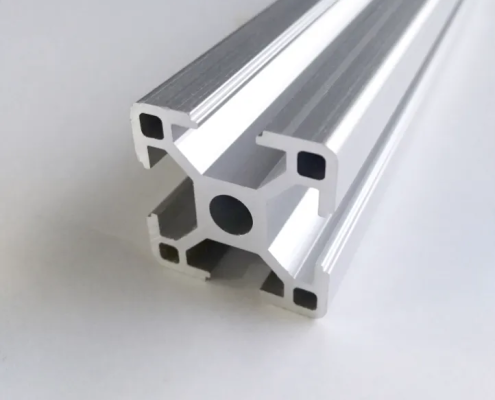Characteristics of titanium aluminum alloy profiles and their processing technology
Aluminum-titanium alloy profiles add alloy elements to industrial pure titanium to improve the strength of titanium. Titanium alloys can be divided into three types: titanium alloy, b titanium alloy, and a+b titanium alloy. ab titanium alloy is composed of a and b dual phases. This type of alloy has a stable structure, good high-temperature deformation performance, toughness, and plasticity. It can be quenched and aged to strengthen the alloy.

The performance characteristics of titanium alloy are mainly reflected in:
1)High specific strength. Aluminum-titanium alloy profiles have a low density (4.4kg/dm3) and are light in weight, but their specific strength is greater than ultra-high-strength steel.
2) High thermal strength. Aluminum-titanium alloy profiles have good thermal stability, and their strength is about 10 times higher than that of aluminum alloys at 300 to 500°C.
3) High chemical activity. Titanium can produce strong chemical reactions with oxygen, nitrogen, carbon monoxide, water vapor, and other substances in the air, forming TiC and TiN hardened layers on the surface.
Poor thermal conductivity. Titanium alloy has poor thermal conductivity. The thermal conductivity of titanium alloy TC4 at 200℃ is l=16.8W/m·℃, and the thermal conductivity is 0.036 cal/cm·s·℃.
Analysis of machining characteristics of aluminum-titanium alloy profiles
First of all, the thermal conductivity of titanium alloy is low, only 1/4 of steel, 1/13 of aluminum, and 1/25 of copper. Because the heat dissipation in the cutting area is slow, it is not conducive to thermal balance. During the cutting process, the heat dissipation and cooling effect are very poor, and it is easy to form high temperatures in the cutting area. After processing, the parts deform and rebound greatly, resulting in increased cutting tool torque and rapid edge wear. Durability reduced. Secondly, the thermal conductivity of titanium alloy is low, which makes the cutting heat accumulate in a small area around the cutting tool and is not easy to dissipate. The friction on the rake face increases, making it difficult to remove chips. The cutting heat is not easy to dissipate, which accelerates tool wear. Finally, titanium alloys are highly chemically active and tend to react with tool materials when processed at high temperatures, forming coatings and diffusions, resulting in phenomena such as sticking, burning, and breakage.
The selection of tool materials should meet the following requirements:
Sufficient hardness. The hardness of the tool must be much greater than the hardness of the aluminum-titanium alloy.
Sufficient strength and toughness. Since the cutting tool is subjected to large torque and cutting force when cutting aluminum-titanium alloy, it must have sufficient strength and toughness.
Sufficient wear resistance. Due to the good toughness of titanium alloy, the cutting edge must be sharp during processing, so the tool material must have sufficient wear resistance to reduce work hardening. This is an important parameter when selecting cutting tools for processing titanium alloys.
The affinity between tool materials and titanium alloys is poor. Due to the high chemical activity of aluminum-titanium alloys, it is necessary to prevent the tool material from forming an alloy with the aluminum-titanium alloys by dissolving and diffusing, causing sticking and burning of the tools.


